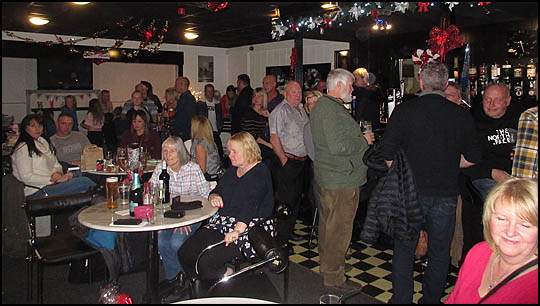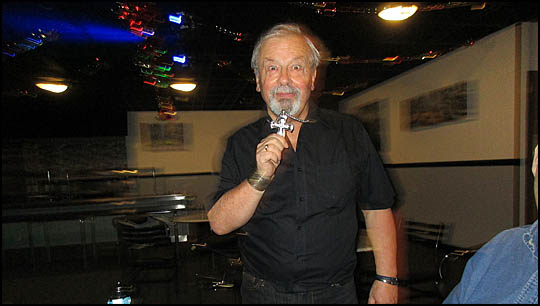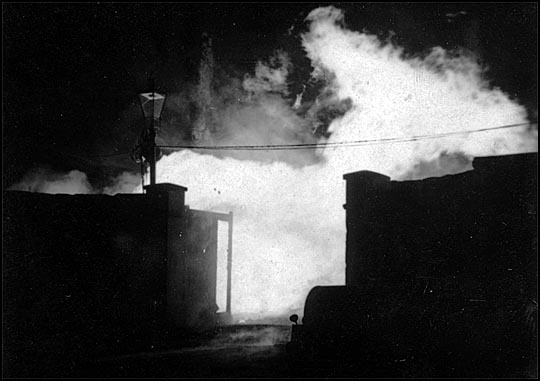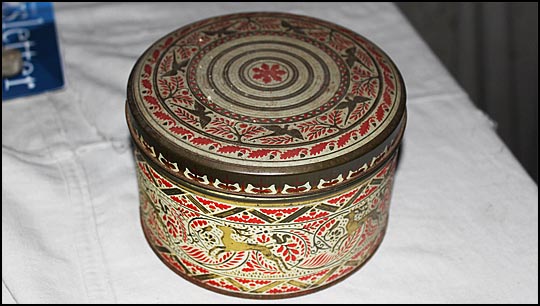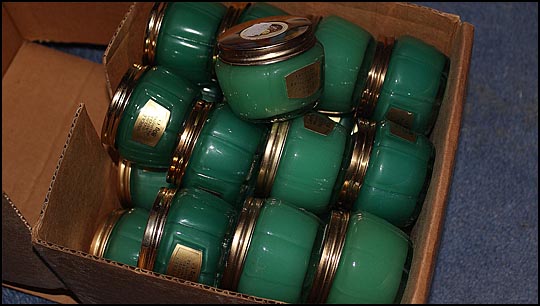So few houses have a cellar these days, but my late uncle's house, which had previously been my grandparents' house, not only had a full height attic but a full cellar as well. One corner was used as a storage for coal, with a trap door in the front path that the coal men could tip their sacks of coal down.

It was the last room of the house for us to look through and we weren't really expecting to find much of value in it. And in that we weren't disappointed! My Grandad had his workbench down there. Equipped with a large vice on either side it was used for woodworking and probably metalworking too as his trade was as an engineer. We found lots of taps and dies for cutting threads in both screws and screw holes and for all I know he may well have made the taps and dies himself as well.

The first thing to catch my eye was this rather gruesome looking figurine. Made of early plastic I remember it from being small when this topless grass-skirted beauty induced both embarrassment and a strange fascination for a twelve-year-old! The years have not been kind to her...
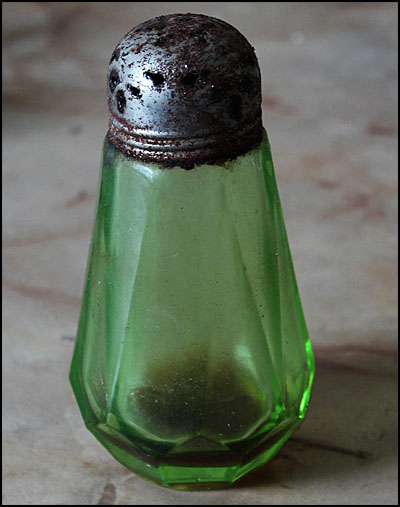
A vinegar bottle, complete with traces of vinegar in the bottom. Over the last twenty, thirty or even forty, fifty, sixty, or seventy years, the fumes from the vinegar have eaten away at the metal cap, enlarging the sprinkler holes and creating a few new ones!

My uncle had his photographic darkroom down here, though at one time he had been making preparations to move it upstairs into the attic. It was - by design I suppose - dark in there! A new stainless steel sink and drainer was propped against the wall either taken out, or waiting to be fitted, I'm not sure. There were still jars of chemicals, labels long since made unreadable. Developers, fixers, toners, model aircraft fuel? Who knows... Against walls shelves held faded tins of motor oil, old Christmas sweets tins full of paper clips, pen nibs and rotted rubber bands and a cardboard tube of some probably toxic toilet cleaner.
There's also a tin of grease here. Cars in the 1960s had to be greased regularly by pumping grease from a hand pump into nipples set into axles and other moving parts. The tins had an inner lid with a hole that when pushed down, dispensed an inch thick rope of grease, like squeezing a toothpaste tube. For some reason motor grease was hugely attractive to earwigs and by the time of a tin's second use, there would be several of them either crawling about, or immobilised by the stuff requiring you to scrape their bodies out...

A Valor paraffin heater. These were in use every winter to heat those rooms without any heat or where you only needed a small amount of heat to keep water pipes from freezing etc. They burnt paraffin which you bought in gallon tins and they smelt and had to be sited carefully as if one was knocked over it could easily start a disastrous fire. One of the more memorable TV adverts of the early 1960s was for Esso Blue paraffin.
I of course replied, "with lower grades one buys
smoke gets in your eyes!"
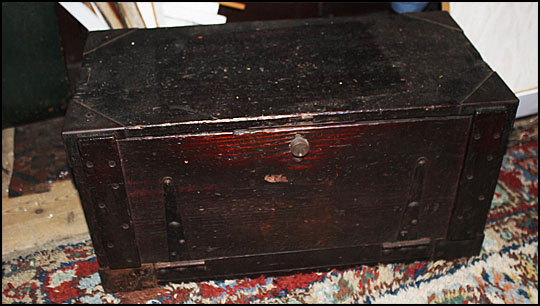
A strong box. Iron bound. Locked. Entrancing, exciting... did we have any pirates in our ancestry? It took us a while to find a key which was eventually found elsewhere in the house. With amazement I turned the key easily in the lock and opened the lid to see... more woodworking tools...

A 1955 Wolf Cub electric drill. Costing five pounds nine shillings and sixpence or yours for a five shillings deposit plus two shillings post and packing followed by six monthly payments of nineteen shillings and sixpence.

There were lots of tins. My brother opened this without looking at the description and poked his finger in. "Eeeew! It's some sort of white gunk!" he said, regarding his sticky white digit.
"I think you'd better go and wash your hands..." I said. Before plastic rawl plugs that enabled you to screw into walls, you drilled a hole, spooned in some of this asbestos paste, left it to harden and then screwed into it.

A Hotpoint rotary ironer for fast ironing of washing. Fitted with a 1940s Wylex plug.

More paraffin heaters. Smaller and more easily knocked over than the Valor, these burned with a blue flame and the thin metal cage under the cone-shaped top would glow red hot, the heat being reflected forward by the large reflector. There is little protection in front of it - plenty of space for fingers or even a small child's entire hand to get through that grill on the front.
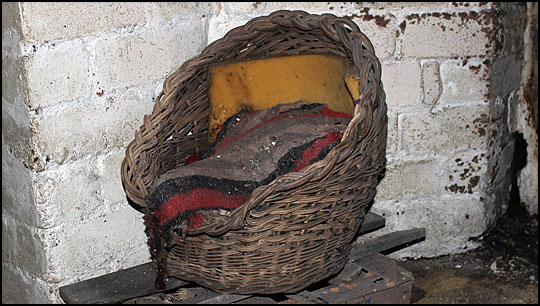
The cat's basket, sitting in a stone sink under the cellar window. The cat this belonged to was called Sooty, a tiny demented ball of speedy black fluff when a kitten in 1963, he grew into a right bruiser of a cat, but died in 1974 after having to have an operation to remove a tumour. This cat basket has stood here for 43 years...

I've no idea how long it has been since these large ceramic electricity fuseboxes were in use, but they too have been lying on the workbench for a long time!

Trench art - two shell cases, I suspect from the First World War, one still with fire irons. When houses were heated by an open coal fire it was essential to have a set of fire irons. They comprised of a metal poker to stir the coal and mix the layers of warm and cold pieces; a pair of tongs to put fresh pieces of coal on the fire (it was usually wet from bringing it in out of the rain and in any case left your hands black if you touched it) They were also used to quickly retrieve pieces of red hot, burning, coal that fell out and rolled onto the floor before the carpet (or cat) set on fire! Finally there would be a small dustpan and brush to tidy up any coal dust that fell off the pieces of coal or to sweep the hearth once you had taken out the ashes of a dead fire before making a new one.

A house fire would be made on a grating in the fireplace, with either some twists (known as "spills") of paper or perhaps a commercial firelighter - Zip Firelighters were a well-known make. On top of this you would build a latticework of firewood to rest the coal on. The cellar fireplace still had a pile of firewood waiting to be used. It had been waiting since the 1950s.

More chemicals. On the left is one of those grease guns I was talking about earlier. Somewhat rusted now, but you gripped the bottom and pushed the nozzle against the nipple on the car and the body of the gun would slide up the tube at the top, pumping grease through the nozzle into the car's innards. When the gun was empty you unscrewed the bottom and refilled it with grease and earwigs. There's a bunsen burner there too - probably used my my Grandad in his metalworking. Or to light his pipe...

A bit of personal nostalgia. A 1950s Ludo board. A long time since I pushed a counter on that board!

And to finish this time, as we are almost into December now, a sheet of charity stickers from Christmasses of the 1950s. In those days whilst proceeds went to charities, their name would not be plastered all over the sticker (which was not sticky - you had to lick the gum on them). We would be disappointed as kids had a present not had one of these charming little Christmas scenes on them. I might put one on the presents I send this Christmas!
